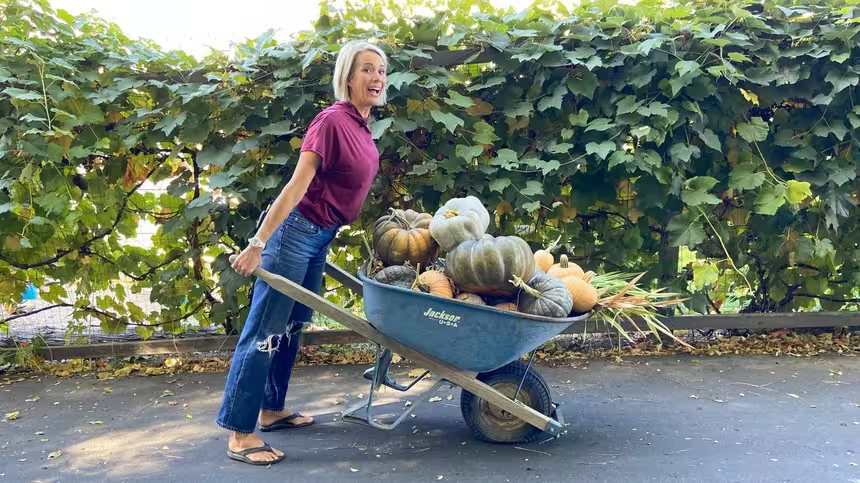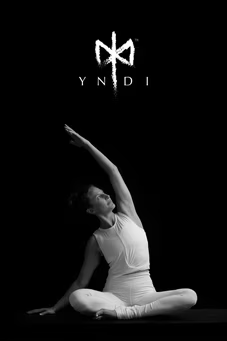Modern Gardener
Growing Vegetables in Your Flower Beds
Episode 78 | 9mVideo has Closed Captions
Cynthia Stringham gives us the scoop on growing vegetables right into your flower bed.
When planting veggies this Spring, you may be thinking more about soil and water than aesthetics. But what if your front yard could be both beautiful and produce food? Inspirational Master Gardener Cynthia Stringham shows us her beautiful front yard landscape and gives us the scoop on growing vegetables right into your flower bed.
Problems playing video? | Closed Captioning Feedback
Problems playing video? | Closed Captioning Feedback
Modern Gardener is a local public television program presented by PBS Utah
Funding for Modern Gardener is made possible in part by Merit Medical and Red Butte Garden & Arboretum.
Modern Gardener
Growing Vegetables in Your Flower Beds
Episode 78 | 9mVideo has Closed Captions
When planting veggies this Spring, you may be thinking more about soil and water than aesthetics. But what if your front yard could be both beautiful and produce food? Inspirational Master Gardener Cynthia Stringham shows us her beautiful front yard landscape and gives us the scoop on growing vegetables right into your flower bed.
Problems playing video? | Closed Captioning Feedback
How to Watch Modern Gardener
Modern Gardener is available to stream on pbs.org and the free PBS App, available on iPhone, Apple TV, Android TV, Android smartphones, Amazon Fire TV, Amazon Fire Tablet, Roku, Samsung Smart TV, and Vizio.

Modern Gardener
Subscribe to the Modern Gardener YouTube channel for more videos and information on gardening, and share your gardening tips and stories in the comments section. Can't wait to GROW with you!Providing Support for PBS.org
Learn Moreabout PBS online sponsorship- When you're planning your vegetable garden, you're probably thinking a lot about sun, soil, and water and not a whole lot about the aesthetics of your vegetables.
(light music) Today, we're in Holladay, Utah to talk to Cynthia Stringham, the inspirational home gardener behind Melon Monologues, about how she interplants veggies into her front yard landscape.
- [Cynthia] My celery's flowering.
This is like mm.
- Oh it's really pretty.
Don't forget to subscribe to "Modern Gardener" so that you don't miss more great information about growing your own food in Utah.
Thank you so much, Cynthia, for having us out today.
I've been looking forward to talking to you about this topic for a really, really long time.
Before we get into talking about putting veggies into your front yard landscape, I wanna know just a little bit about how long you've been gardening, why you love it.
- I have been gardening for quite a bit.
I mean, as a child, my dad was the veggie gardener, my mom was the flower gardener, and I just loved working with them out in the yard.
- That's so great.
You've got this great property here.
We won't get into it too much in this video, but you have an incredible backyard garden that is just so many beautiful things growing.
Even with your backyard garden, you still felt more need (laughing) for veggies.
- I always feel more need.
- I know.
- If I didn't have four boys, I would have no grass and we would have more vegetables.
More, more, more.
No, yes, I'm always looking for ways to extend my garden, especially on the produce side, just because we actually eat from our garden daily, even throughout the winter.
But I have a problem, which is I love flowers too, so I'm always trying to figure out ways that I can squeeze everybody in at the same time.
(light music continues) Look at that zinnia.
It was just understanding how great it is for everything to grow together.
It really helps with pest control, it helps vegetables grow well, and then, when you pull something out, you have something that's gonna come in its place so it doesn't feel like there's a giant empty hole all the time.
- That's a really great point.
Because I'd say if there were one way that I would characterize your front yard landscape is bounty.
I mean, everything is just always seeming to be (laughing) so full.
- There's always something coming on, that's for sure.
- Yeah, for sure.
- For better or for worse.
(laughing) (light music continues) - So, when you're first starting to put vegetables into your landscape, I mean, what's your process for planning all of this?
In January when you're thinking about your season coming up ahead, how do you get that started?
- For sure, so there's a few key things that I go for.
I'm always kind of looking at the height of things.
The way I like to do it is, I will incorporate things into lines.
That way, I have a row of vegetables, a row of flowers, like I'll start with something really low, like a sweet alyssum.
And then, I will plant something that is kinda low or shorter, like that I'll be pulling up frequently, like a beet, for example.
And then I'll plant like another flower, and then I'll plant something that maybe I won't be harvesting until later in the season, like a brussels sprout, so that it has room to grow, that it can get nice and tall.
But then I'll put another layer of flowers behind it, and the flowers will help protect.
So I kind of do things in lines so that when I pull things outta the ground, something's behind or in front of it that's gonna fill in.
- Oh, I see.
Right, because that's really the big part of planting your veggies in the front yard is aesthetics.
- You gotta wanna make it look pretty, right?
I mean, the backyard is pretty on its own, but it's a different kinda pretty.
- Right, right.
- It's very, I mean, everything's in rows.
It has function.
Where up here, it's like I wanted to make it function and beautiful at the same time.
- (laughing) You wanna be in "Better Homes and Gardens."
- Yes, I wanna be on "Modern Gardener."
(laughing) That's kinda my logistics.
Plus, it's great, I love having talking points when neighbors are coming around.
And they're like, "Look at this beautiful flower.
Wait, is that an artichoke next to it?"
And then I say, "And guess what else is in here?
Celery, okra, tomatillos, we got it all."
You know what I mean?
You become your own natural farmers' market.
- Yeah, for sure.
- Or grocery store.
- For sure, there's, I just can only see benefits to doing it.
- You can see all the celery's in here.
Here are some artichokes.
Actually, I have some peppers in here too.
Here's an artichoke blooming.
This is my pumpkin plant.
(light music continues) - So when you're planning out your garden, how much are you really thinking about companion planting in terms of pest control?
- In general, I don't plant certain groups of crops, like my brassicas, I won't plant with my tomatoes, 'cause they're both competing for the same nutrients in the soil.
- Okay.
- As far as flowers go, I don't think like, "Okay, I need to have this particular flower next to this particular plant."
I will look more of, how full does this flower get and is it going to overpower some of my plants?
Up front, actually, is perfect example where I have peppers and I wasn't thinking about how this plant was gonna overpower the peppers so much.
I wanted some shade on the pepper, but it almost outweighed and covered the pepper plant.
So here's this sad little pepper that's like, "Help me."
So it's, I mean, really, just kind of experimental and just trial and error.
I mean, sad that I don't get the peppers, but I have some beautiful dahlias in front.
- Right, yeah.
So when it comes to companion planting, I just always imagine like the incredible spreadsheet I would need to have.
- Oh, I know.
No, I mean, I think.
- Just take that really seriously.
- And I think people do take it seriously and I commend them for it.
But I've learned that you really don't, you're bringing in the pollinators with any kind of flowers that you grow.
And with that also comes all the beneficial insects, the ones that you're looking for, like lacewings or ladybugs that are gonna eat all those aphids off your brassicas.
- So then what are some of your favorite veggies and flowers to put into your front yard?
- I use a lotta sweet alyssum.
I don't like it, per se, as a flower, but it's a huge beneficial insect attractor.
So I love sweet alyssum.
I love zinnias for the color and also they are great for all those pollinators out there.
And then, for first-time gardeners, lettuce is really easy if you're starting in the spring.
Lettuce, green onions, beets.
Like I said, zucchini, cucumbers, those are kind of easier ones to start.
(light music continues) - How much do you consider the water needs of your veggies with your flowers?
- The flowers up front, they're gonna definitely need some more water.
I'll put the vegetables that need more water up with them.
But things that are more drought-tolerant that don't require so much, they kinda tend to always stay in the back.
- Okay, what other things are really, really big for you when it comes to doing edible landscaping?
- I tell this to a lotta people because they think this is how their garden's gonna look the first year, and I'm not trying to be like a naysayer or a negative Nelly or anything.
I just wanna let people know, your first year gardening is going to be hard.
It's going to be a little tricky and you're gonna have a lotta fails, but I promise if you stick with it, the next year is going to be even better.
So it really is, it's a total learning process, and even though it seems so hard, because it's like, "Oh, my season's gone.
One year of gardening gone," it really, you'll get into the flow and you'll start figuring out the next year will be better.
You'll start finding new problems, but then every year after that, it just builds on itself.
So, I would recommend for any gardener that's gonna start, first-time gardening, start small, pay attention, keep a journal, and don't be hard on yourself.
You're gonna be okay.
(laughing) And if you don't grow produce, thankfully there's plenty of places to buy it.
- Well, and you've learned something - Oh yes, you learn.
- In the process, - And you know - even if you lost it.
- Check your frost dates, cover your crop.
Like, every year, you're gonna improve upon it.
And it's not like this instant gratification master's workshop.
It takes time to develop this skill, and that's the beauty of it.
While your garden's growing, you are as well.
(light music continues) - I hope you've been inspired by what we've learned from Cynthia to grow more veggies of your own.
If you have ideas to share, please leave them in the comments section below.
(light music continues) I think that's probably good.
- We good?
(light music)


- Home and How To

Hit the road in a classic car for a tour through Great Britain with two antiques experts.












Support for PBS provided by:
Modern Gardener is a local public television program presented by PBS Utah
Funding for Modern Gardener is made possible in part by Merit Medical and Red Butte Garden & Arboretum.
